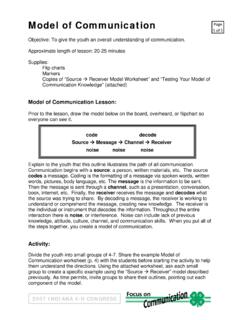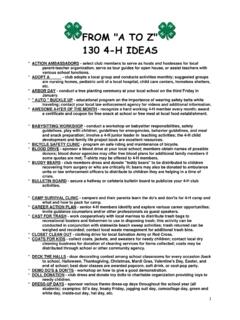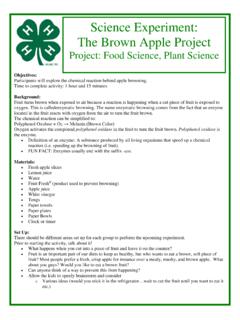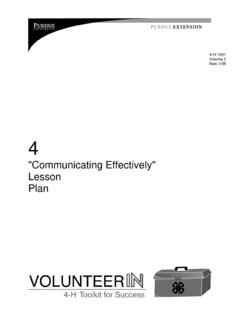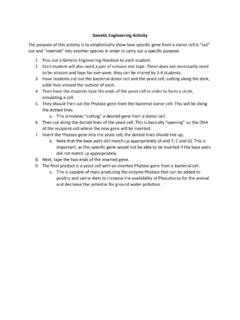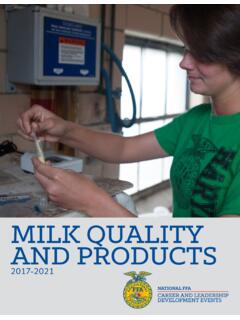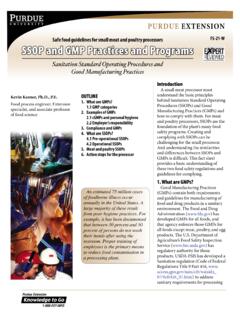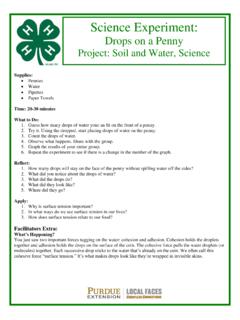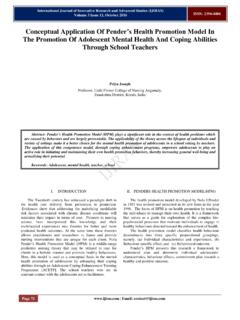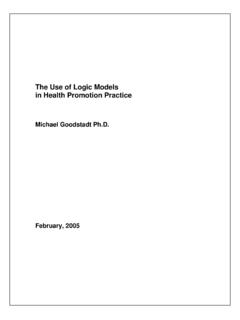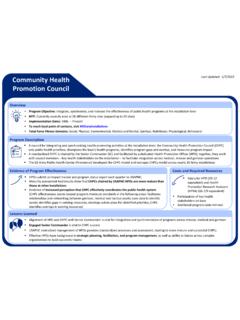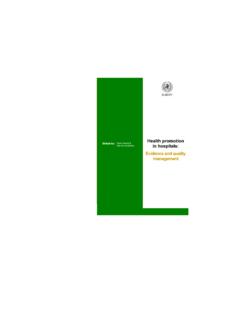Transcription of Models and Theories to Support Health Behavior ...
1 HHS-792-WHealth and Human SciencesModels and Theories to Support Health Behavior Intervention and Program Planning Vicki Simpson PhD, RN, CHES, Purdue School of NursingDeveloping Health promotion programs that Support healthy lifestyle behaviors requires comprehensive planning. Program planners can use Models and Theories to guide this process as they work with individuals, groups, and communities. Individuals and communities have multiple risky lifestyle behaviors including physical inactivity, unhealthy diets, smoking, and stress. Also, there are often many factors that can affect an individual s or community s ability to effectively change behaviors, including low income, lack of access to safe places to exercise, inaccessibility of healthy food, and cultural and ethnic factors can make determining how to best design a program seem like an overwhelming task.
2 To be effective, programs must not only address the Behavior , but also the factors that surround it. Models and Theories can provide a framework for program planners to build upon as they develop Health promotion publication discusses three Models or Theories related to Health Behavior change that can help planners design effective Health promotion programs: socioecological, transtheoretical, and Health belief. Before describing these Models , it is useful to first understand some basic terms, including theory, model , concept, and ConceptsMerriam-Webster defines a theory as an idea or set of ideas that is intended to explain facts or events.
3 Models refer to a more descriptive process. In other words, a model may describe how a process occurs but not necessarily why it occurs in that and Models both include concepts and constructs. Concepts are the primary components of a model or theory. Constructs are components that have been created for use in a specific model or theory. These terms are important to understand when discussing Models and Theories (Glanz, Rimer, & Lewis, 2002). Health Behavior Models and Theories help to explain why individuals and communities behave the way they do. Planners can use these Models and Theories to increase the effectiveness of their program design, implementation, and evaluation.
4 It s useful to remember that different Models may be appropriate in different situations. There is no one-size-fits-all approach; each individual or community requires programming that is tailored specifically to their that programming may require planners to consider multiple Models or Theories when they develop programs and interventions to Support lifestyle Behavior changes. A mix of approaches helps to provide the best Support and guidance to individuals, groups and communities as they work to develop healthy lifestyle behaviors (Glanz, Rimer, & Lewis, 2002). 2 Socioecological ModelThe first model , the socioecological model , addresses Behavior change at multiple levels and considers the inter-relationship between Behavior and the environment.
5 The model accounts for multiple factors that can influence the Behavior change model identifies five levels of influence on Health Behavior and discusses the reciprocal relationship between them (Stokols, 1996; McLeroy, Bibeau, Steckler, & Glanz, 1988): 1 . Intrapersonal factors these include individual characteristics such as knowledge, beliefs, and self-concept. Most Health promotion programming is aimed at this Interpersonal processes and primary groups these include the individual s social environment such as family, friends, peers, and co-workers that surround the individual and influence Behavior .
6 In turn, an individual s Behavior also influences family, friends, and peers (National Cancer Institute [NCI], 2005).3. Institutional or organizational factors these refer to workplaces, churches, and other organized social institutions. These institutions have formal or informal policies and Community factors these describe the relationships among organizations and institutions. This includes community norms. 5. Public policies these refer to policies or regulations concerning healthy the socioecological model , an individual s Behavior influences and is influenced by factors in the other levels (Glanz, Rimer, & Lewis, 2002).
7 Using this model allows a program planner to consider factors from multiple levels that can impact example, to develop programming for adult obesity, a planner must first understand the policies, structures, behaviors, and norms that Support obesity in the community. Communities that do not have access to healthy food or low-cost exercise options will have difficulty supporting an individual who attempts to become healthier. While individual lifestyle factors are important to consider, this model encourages the planner to identify interventions to influence factors where individuals live, work, and play.
8 See Figure 1. A socioecological approach to obesity. This figure shows interventions that program planners can take at each level of the socioecological model to implement a Health program that targets Advocate for legislation that supports healthy policies Apply for funding to address obesityCommunity Develop social media campaigns with Health messages Work with communities to provide healthy food optionsInstitutional Encourage workplaces to provide environments that Support Health with fitness facilities, healthy food optionsInterpersonal Encourage individuals to exercise with peers Offer community walking groupsIntrapersonal Factors Educate communities about strategies to decrease obesity Encourage counseling to increase self-confidence3 Transtheoretical model (Stages of Change)The transtheoretical model describes the process of Behavior change and accounts for an individual s readiness to make and sustain Behavior changes.
9 This model is useful because it helps planners design programs based on an individual s readiness, motivation, and model includes five stages (Glanz, Rimer, & Lewis, 2002; NCI, 2005): 1. Precontemplation in this stage, the individual has no intention to change Behavior within the next six months. The individual may lack knowledge or may have been unsuccessful with previous attempts at a Contemplation in this stage, an individual is considering a Behavior change within the next six months. Ambivalence, however, may keep the individual from progressing to the next Preparation in this stage, the individual takes some steps toward making a change and doing so within the next 30 Action an individual reaches this stage once he or she has made an apparent Behavior change for six months or Maintenance if the individual s Behavior change lasts for more than six months, he or she moves into the final stage, is important to be aware that this process can be cyclical.
10 Individuals may start at one stage and progress forward, or may go backward. The model includes several other important concepts that help describe factors or activities that occur as individuals attempt to make a Behavior change. These include weighing the benefits and costs of making a change, evaluating the impact of the change, finding Support for the change, and determining whether or not they can confidently make the change to a healthy Behavior (Glanz, Rimer, & Lewis, 2002; NCI, 2005).While there are some similarities to the socioecological model , this model focuses on helping the individual to move through the stages toward a sustained Behavior change.
